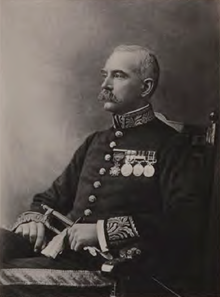John Claude White
John Claude White | |
|---|---|
 | |
| Born | 1 October 1853 Kolkata |
| Died | 1918 |
| Occupation | Photographer |
| Signature | |
 | |
John Claude White (1 October 1853 – 1918) .
Early life
The son of army surgeon John White (1871–1920) and Louise Henriette (Claude) Pfeffer White, he was born in Calcutta (now Kolkata), India. His education included a period at Rugby School for six months in 1868. White later studied at the Royal Indian Engineering College in Cooper's Hill, Surrey before joining the Bengal Public Works Department as Assistant Engineer in 1876.[1]
India and Sikkim
White originally worked in Bengal, Nepal and Darjeeling. In 1883, he was assigned to the British Residency in Kathmandu, Nepal where he photographed the architecture and monuments.[2]
In 1889, White was appointed
Following the 1890

In 1903, the
White is claimed to have been the only member of the Tibet expedition permitted to photograph Lhasa's monasteries.[2]
He made five trips to Bhutan and in 1907 photographed the coronation of the country's first king.[2]
Personal life
On 12 September 1876, before departing for India, White married his distant cousin Jessie Georgina Ranken at All Saints Church in Kensington, London. They had a daughter, Beryl born in Bengal in 1877.[1]
Photography
White created a rich and detailed photographic account of the culture and scenery of the Himalayas during his travels through the region. John Falconer, curator of photographs at the British Library’s Oriental and India Office Collections described White's work as "probably one of the last, and certainly among the most impressive products of a tradition of quasi-amateur photography which had flourished among administrators and military personnel in India since the 1850s."[6]
The 2005 book In the Shadow of the Himalayas: Tibet, Bhutan, Nepal, Sikkim : a Photographic Record by John Claude White, 1883–1908 contains an anthology of Himalayan photos taken by White.
Works
- Sikhim & Bhutan: Twenty-one years on the North East Frontier 1887–1908. London: Edward Arnold. 1909.
See also
References
- ^ a b c "John Claude White – career". King's College London. Retrieved 19 August 2015.
- ISBN 978-1-4828-4871-7.
- ^ a b Younghusband 1910, p. 54.
- ^ ISBN 978-0-14-196430-0.
- ^ "John Claude White – politics". King's College London. Retrieved 19 August 2015.
- Bibliography
- Younghusband, Francis (1910). India and Tibet: a history of the relations which have subsisted between the two countries from the time of Warren Hastings to 1910; with a particular account of the mission to Lhasa of 1904. London: John Murray.
Further reading
- Meyer, Kurt; Meyer, Pamela Deuel (2005). In the Shadow of the Himalayas: Tibet, Bhutan, Nepal, Sikkim : a Photographic Record by John Claude White, 1883–1908. Mapin. ISBN 978-1-89-020661-1.
External links
 Media related to John Claude White at Wikimedia Commons
Media related to John Claude White at Wikimedia Commons Works by or about John Claude White at Wikisource
Works by or about John Claude White at Wikisource
